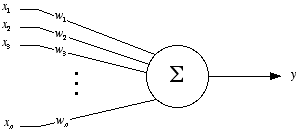PSC 128/NPB 163
Linear neuron models
Definition of a linear system
- A linear system is one in which the input-output behavior
may be described in terms of a linear function.
- What is a linear function? - obeys the rules of superposition
and scaling.
- Example: A one-dimensional linear system with input x
and output y may be characterized as
 .
.
- Linear algebra provides a powerful tool for the
analysis of complex, multivariate systems.
- Although most systems in nature are non-linear, our understanding
of them can still be aided by the intuitions and insights gained from linear
systems analysis.
Neurons
- The brain contains approximately
 neurons. Each neuron can essentially be thought of as a device having
a number of inputs and a single output. The inputs consist of the currents
generated by the approximately
neurons. Each neuron can essentially be thought of as a device having
a number of inputs and a single output. The inputs consist of the currents
generated by the approximately  -
-  synapses on the dendritic tree, and the output consists of the action potentials
carried by the axon. The axon branches so as to make many copies of the
output which are sent on to other neurons.
synapses on the dendritic tree, and the output consists of the action potentials
carried by the axon. The axon branches so as to make many copies of the
output which are sent on to other neurons.
- The overall input-output characteristic of a neuron is
very complicated and still not fully understood. What we do know is that
the input currents are generated by ion-specific channels in the membrane
which change their conductance in response to chemicals (neurotransmitters)
released by other neurons. These currents are (roughly) summed together
into the soma, whose voltage rises and decays with the fluctuations in current.
When the soma voltage exceeds a certain threshold, an action potential is
generated, which then propagates down the axon.
- A conventional way of attempting to understand a neuron
is to break it up into many small elements, or compartments. The
membrane potential of a given compartment is determined by the conductances
of the various ion channels within it. For the Na, K, and Cl ion channels,
we have

where  is the membrane voltage,
is the membrane voltage,  denotes the conductance of the ion channel selective to ion x, and
denotes the conductance of the ion channel selective to ion x, and
 denotes the reversal potential (or so-called Nernst potential) of ion x.
denotes the reversal potential (or so-called Nernst potential) of ion x.
- Note that
 is not a linear function of the conductances. In addition, the action-potential
is a highly non-linear function of
is not a linear function of the conductances. In addition, the action-potential
is a highly non-linear function of  .
.
Linear neurons
- Despite the non-linearities mentioned above, it is still
possible to build a simplified, linear model of a neuron that provides useful
insights about the function of neurons in the brain.
- A schematic of a linear neuron model is shown below:

Each input  is multiplied by a corresponding weight
is multiplied by a corresponding weight  and these values are summed together to form the output y. Thus,
the output is given as a function of the inputs and weights by the equation
and these values are summed together to form the output y. Thus,
the output is given as a function of the inputs and weights by the equation

or, in vector form,  , or
, or  .
.
- The inputs
 in a linear neuron model can be thought of as the action potentials from
other neurons that are impinging upon the neuron’s synapses. The weights
in a linear neuron model can be thought of as the action potentials from
other neurons that are impinging upon the neuron’s synapses. The weights
 can be thought of as the efficacies of the synapses. The larger
can be thought of as the efficacies of the synapses. The larger
 , the the more
, the the more  affects the neurons output. Some of the factors in a real neuron that would
determine
affects the neurons output. Some of the factors in a real neuron that would
determine  are the number of synaptic vescicles in the presynaptic terminal, or the
number of ligand-gated channels in the post-synaptic membrane. The sign
of
are the number of synaptic vescicles in the presynaptic terminal, or the
number of ligand-gated channels in the post-synaptic membrane. The sign
of  reflects whether it is an excitatory or inhibitory synapse.
reflects whether it is an excitatory or inhibitory synapse.
- A slight but useful modification of the linear neuron above
is to add a non-linear threshold function at the output, which is meant as
a crude model of an all-or-nothing action potential generated by a neuron.
In this case, the output is given by

where

 .
. .
. neurons. Each neuron can essentially be thought of as a device having
a number of inputs and a single output. The inputs consist of the currents
generated by the approximately
neurons. Each neuron can essentially be thought of as a device having
a number of inputs and a single output. The inputs consist of the currents
generated by the approximately  -
-  synapses on the dendritic tree, and the output consists of the action potentials
carried by the axon. The axon branches so as to make many copies of the
output which are sent on to other neurons.
synapses on the dendritic tree, and the output consists of the action potentials
carried by the axon. The axon branches so as to make many copies of the
output which are sent on to other neurons.



